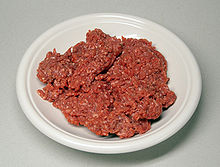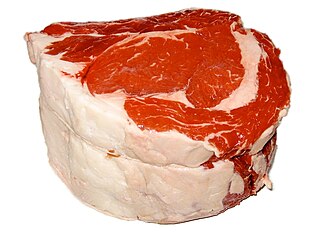
Beef is the culinary name for meat from cattle. Beef can be prepared in various ways; cuts are often used for steak, which can be cooked to varying degrees of doneness, while trimmings are often ground or minced, as found in most hamburgers. Beef contains protein, iron, and vitamin B12. Along with other kinds of red meat, high consumption is associated with an increased risk of colorectal cancer and coronary heart disease, especially when processed. Beef has a high environmental impact, being a primary driver of deforestation with the highest greenhouse gas emissions of any agricultural product.
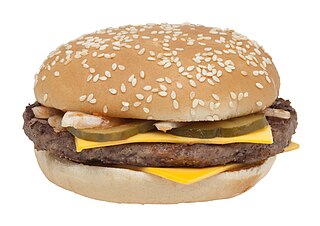
A hamburger, also called a burger, is a food consisting of fillings—usually a patty of ground meat, typically beef—placed inside a sliced bun or bread roll. The patties are often served with cheese, lettuce, tomato, onion, pickles, bacon or chilis with condiments such as ketchup, mustard, mayonnaise, relish or a "special sauce", often a variation of Thousand Island dressing and are frequently placed on sesame seed buns. A hamburger patty topped with cheese is called a cheeseburger.

Advanced meat recovery (AMR) is a slaughterhouse deboning process by which the last traces of skeletal muscle meat are removed from animal bones after the primal cuts have been carved off manually. The machinery used in this process separates meat from bone by scraping, shaving, or pressing the meat from the bone without breaking or grinding the bone. AMR meat typically is used as an ingredient in products requiring further processing, such as hot dogs. Unlike mechanically separated meat, AMR meat is comparable in appearance, texture, and composition to meat trimmings and similar meat products derived by hand.

Mechanically separated meat (MSM), mechanically recovered/reclaimed meat (MRM), or mechanically deboned meat (MDM) is a paste-like meat product produced by forcing pureed or ground beef, pork, mutton, turkey or chicken under high pressure through a sieve or similar device to separate the bone from the edible meat tissue. When poultry is used, it is sometimes called white slime as an analog to meat-additive pink slime and to meat extracted by advanced meat recovery systems, both of which are different processes. The process entails pureeing or grinding the carcass left after the manual removal of meat from the bones and then forcing the slurry through a sieve under pressure.

Salisbury steak is a dish originating in the United States and made from a blend of ground beef and other ingredients, being considered a version of Hamburg steak. Today, Salisbury steak is usually served with a gravy similar in texture to brown sauce, along with various side dishes, such as mashed potatoes and cooked vegetables. It is a common menu item served by diners and is frequently available as a TV dinner in supermarket frozen food sections.

A round steak is a beef steak from the "round", the rear leg of the cow. The round is divided into cuts including the eye (of) round, bottom round, and top round, with or without the "round" bone (femur), and may include the knuckle, depending on how the round is separated from the loin. This is a lean cut and it is moderately tough. Lack of fat and marbling makes round dry out when cooked with dry-heat cooking methods like roasting or grilling. Round steak is commonly prepared with slow moist-heat methods including braising, to tenderize the meat and maintain moisture. The cut is often sliced thin, then dried or smoked at low temperature to make jerky.

Çiğ köfte or chee kofta is a kofta dish that is a regional specialty of southeastern Anatolia in Urfa. The dish is served as an appetizer or meze, and it is closely related with kibbeh nayyeh from Levantine cuisine.
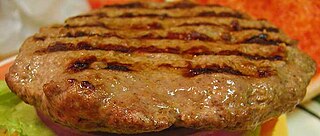
A patty or burger is a flattened, usually round, serving of ground meat or legumes, grains, vegetables, or meat alternatives. Patties are found in multiple cuisines throughout the world.
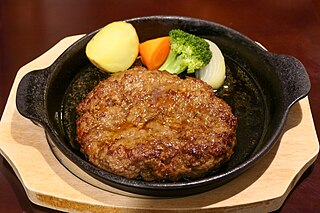
Hamburg steak is a patty of ground beef. Made popular worldwide by migrating Germans, it became a mainstream dish around the start of the 19th century. It is related to Salisbury steaks, which also use ground beef. It is considered the origin of the ubiquitous hamburger, when, in the early 20th century, vendors began selling the Hamburg steak as a sandwich between bread.
Raw meat generally refers to any type of uncooked muscle tissue of an animal used for food. In the meat production industry, the term ‘meat’ refers specifically to mammalian flesh, while the words ‘poultry’ and ‘seafood’ are used to differentiate between the tissue of birds and aquatic creatures.
Empirical Foods, formerly named Beef Products Inc. (BPI), is an American meat processing company based in Dakota Dunes, South Dakota. Prior to high media visibility of its products, it was a major supplier to fast food chains, groceries and school lunch programs. It had three additional plants, which closed in 2012.

Evidence suggests that the United States was the first country where two slices of bread and a ground beef patty were combined into a "hamburger sandwich" and sold. There is some controversy over the origin of the hamburger because its two basic ingredients, bread and beef, have been prepared and consumed separately for many years in both countries before their combination. Shortly after its creation, the hamburger quickly included all of its currently typically characteristic trimmings, including onions, lettuce, and sliced pickles.

The Food Safety and Inspection Service (FSIS), an agency of the United States Department of Agriculture (USDA), is the public health regulatory agency responsible for ensuring that United States' commercial supply of meat, poultry, and egg products is safe, wholesome, and correctly labeled and packaged. The FSIS draws its authority from the Federal Meat Inspection Act of 1906, the Poultry Products Inspection Act of 1957 and the Egg Products Inspection Act of 1970. The FSIS also acts as a national health department and is responsible for the safety of public food-related establishments as well as business investigation.

Lean finely textured beef is a meat by-product used as a food additive to ground beef and beef-based processed meats, as a filler, or to reduce the overall fat content of ground beef. As part of the production process, heat and centrifuges remove the fat from the meat in beef trimmings. The resulting paste, without the fat, is exposed to ammonia gas or citric acid to kill bacteria. In 2001, the United States Department of Agriculture (USDA) approved the product for limited human consumption. The product, when prepared using ammonia gas, is banned for human consumption in the European Union and Canada.

Ground turkey, or minced turkey, is a mixture of dark and light turkey meat with remaining skin and visible fat processed together until a "ground" form emerges. The turkey meat, skin, and fat is taken off the bone and processed with additives. The final product has specific characteristics that appeal to customers, including a non pink color and non crumbly texture. The composition of ground turkey is driven by market demand, availability, and meat prices. The majority of ground turkey is made from excess thighs and drumsticks rather than the more costly breast meat. Ground turkey is a common low-fat alternative for ground beef.

The 1992–1993 Jack in the Box E. coli outbreak occurred when the Escherichia coli O157:H7 bacterium killed four children and infected 732 people across four US states. The outbreak involved 73 Jack in the Box restaurants in California, Idaho, Washington, and Nevada, and has been described as "far and away the most infamous food poison outbreak in contemporary history." The majority of the affected were under 10 years old. Four children died and 178 others were left with permanent injury including kidney and brain damage.

A steak is a thick cut of meat generally sliced across the muscle fibers, sometimes including a bone. It is normally grilled or fried. Steak can be diced, cooked in sauce, such as in steak and kidney pie, or minced and formed into patties, such as hamburgers.

Ground meat, called mince or minced meat outside North America, is meat finely chopped by a meat grinder or a chopping knife. A common type of ground meat is ground beef, but many other types of meats are prepared in a similar fashion, including pork, veal, lamb, goat meat, and poultry.
